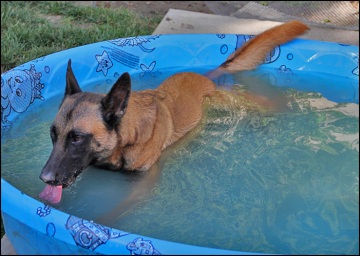Summer has finally taken a hot grip on our days – while this can mean fun in the water, surfing and chilling at the pool, it can also be potentially dangerous for our furry friends. There are the obvious lethal situations, like keeping dogs in hot cars, which by now, we should all know, can be like ovens at a moment’s notice. Only 10 minutes are enough to rise the temperature by about 20 degrees.
But that’s not all: dogs regulate their body temperature by panting and evaporating water. This means that they need water in the first place, and the air has to be dry and circulated enough to be more saturated with evaporated water. So it’s not just the heat, a closed environment like a crate in a car, no windows open and no water available can send a dog in heat distress even though temperatures may not be over 75 degrees. This is also the reason, why it may not be a good idea to hose down your dog before getting in a confined space like a closed car or a crate, as the wet fur acts like a sauna environment and the air around your dog will saturate with moisture almost immediately, rendering your dog unable to decrease its body temperature by panting.
But it’s also the less obvious situation which can be harmful for your dog. When walking your pooch, try to stay on cool surfaces. Hot asphalt can burn your dog’s paws in no time. Playing fetch or work in hot weather can overheat your K9 partner, seniors, puppies or overweight dogs can even show signs of hyperthermia during a walk outside. If your dog has difficulties breathing or is prone to it like some breeds (Pugs, Boxers, Bulldogs or Penkingese for example), they may not be able to control their body temperature as well as other dogs.
If you leave your dog in your backyard during the day, make sure, there is ample shade and fresh water. When temperatures reach triple digits, your dog may be safer in an AC cooled down house – or have someone check on your dog when you are away.
Some dogs do better with their fur shaven, however, check with breed experts or your vet, as some dogs need the long fur as a protection from the sun. Some dogs who do not have fur like the Chinese Crested or the Mexican Hairless (Xoloitzcuintle) may need additional protection like a light shirt or even sunscreen.
Here are some signs your dog may display when in heat distress:
- Very heavy panting and visible difficulties breathing
- Because blood is flowing close to the surface to cool down, the mucous membranes appear very red
- Possible vomiting
- Staggering, unsteady walk
- Anxiety
- Dry gums and/or excessive salivating
- Possible bloody diarrhea
When shock sets in, the dog may collapse, seizure and the mucous membranes may turn pale. This is when help may be too late and the dog is about to die. Heat distress is very serious and recognizing the signs may be life saving. Once hyperthermia hits, it may be too late.
If your dog displays signs of heat distress, try to cool her down as fast as possible. Move your dog into a cool environment, use cold water on the stomach, between the legs and extremities such as outside of the ears and top of the head. Do not use ice water. Check the temperature and bring your dog to a vet as fast as possible to make sure, no permanent damage has been caused. Effects from hyperthermia can show days after the incident and can be just as life threatening.
It is important to know your dog’s normal body temperature to be able to determine when it is dangerously elevated. Take your dog’s rectal temperature once a week or more often to get your dog used to it and to find out the average level. When you go for a walk with your pooch, bring water for you and your dog. But most importantly, use common sense. If you are too hot, your dog could be uncomfortable, too.



